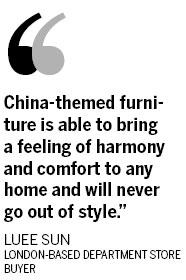
The dining area of the Bamboo House, part of the Commune by the Great Wall-Kempinski property near Beijing. The popularity of Chinese cultural elements in furnishing design in Western countries has grown in part thanks to the release of Chinese film blockbusters and also because tourism to China has risen. [Bloomberg News]
BEIJING - International furniture makers are striving to adopt more Chinese traditional elements into their products to meet growing consumer demand for the oriental look.William Hsieh, chairman of Lifestyle Enterprise Inc, a US-based furniture dealer and supplier, said the trend had developed in recent years.
Luee Sun, a London-based buyer who purchases fashion items for department stores, said that the popularity of Chinese cultural elements in furnishing design in Western countries had grown in part thanks to the release of Chinese film blockbusters and also because tourism to China had risen.
"China-themed furniture is able to bring a feeling of harmony and comfort to any home and will never go out of style," she said.
"Not only has it generated a huge commercial opportunity for our company, but it comes at a time when Chinese furniture makers were changing their old image at international markets because their products were associated with weak design, quality and branding," said Hsieh, who always wears Tangzhuang, a the traditional Chinese garment with delicate embroidery.

A native of Taiwan, Hsieh became a major player in the world of furniture in the 1970s, selling so-called "stop-sign" dining tables to large furniture retailers with his previous company, Datong.
He stepped away from that pioneering import company to serve for five years as a congressman in Taiwan before returning to the US furniture industry and establishing Lifestyle Enterprise Inc in High Point, North Carolina, in 1997.
Taking Steve Jobs, chief executive officer of Apple Inc, as his business idol, Hsieh proudly said that 12 years ago, the chair that Jobs sat on for a magazine advertisement about Apple was sold by Lifestyle.
"Furniture made in China accounts for more than 60 percent of the world's total annual supply volume," said Hsieh. "But there is not an international brand in China or one created by Chinese entrepreneurs."
Drawing upon deep emotions regarding Chinese culture, Hsieh said he believed that Chinese cultural elements would be the most powerful weapon for him with which to expand the company's footprint in Western countries and have a say in the global furniture market.
In 2004, Hsieh spent about $5 million in restructuring the showcase center at High Point into a 30,000 square-foot replica of the Forbidden City, otherwise known as the Palace Museum in Beijing. The company has held "Forbidden City" shows at the venue twice a year since 2006, not only displaying their new collections but also inviting 500 top furniture retailers in the US and also clients across the world to place orders there.
Hsieh said most of Lifestyle's items were made working with Chinese producers in China, from where the inspiration for them came, because of the country's strong manufacturing muscle and competitive costs.
According to statistics provided by the company, it purchased furniture from China worth more than $150 million in 2009. Hsieh said the plan was to boost purchasing volume to more than $350 million within the next two years.
Under the brands of "Shanghai" and "Forbidden City", its Lifestyle products have been sold to 80 countries worldwide. The company's marketing tactic appears to work because it is expecting annual sales to exceed $250 million in 2010, an increase of 40 percent year-on-year.
Some collections have been decorated with traditional Chinese shiny silk fabric and ancient patterns. Others have been elaborately designed with innovative dragon or phoenix patterns and stained or lacquered in dark colors. Simple and plain styles, which tend to be more appealing to the international furniture market buyers, have also been created.
Sun said that the success of Lifestyle could be attributed to the balance the company found between Chinese elements and internationalized tastes. "The concept could also be applied to other enterprises which are marketing China-styled products across the globe," she added.
In late June, Lifestyle wowed more than 400 foreign retailers, distributors and other guests with its first Forbidden City Show at Taimiao, or Imperial Ancestral Temple, inside the Forbidden City, in Beijing.
The company decorated the 15,000-square-foot Hall of Worship of Ancestors with more than 60 new bedroom, living room and dining sets.
These included a range of higher-end Lifestyle products, including several targeted to retail from $1,799 to $1,999.
"It has really been a once-in-a-lifetime experience," said LeAnn Carpenter, a buyer for the two-store Freed's Home Furnishings in Dallas, adding that networking in China was beneficial.
Many other buyers said that the show help them better understand the stories and culture behind Lifestyle's design and products.





